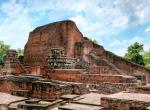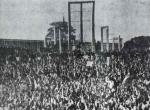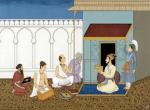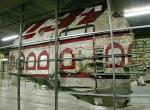Early December 2012 a United Nations Committee ‘tasked with protecting the world’s oral traditions, performing arts, social practices, craftsmanship and knowledge of nature’ added twenty new items to the world List of the Intangible Cultural Heritage of Humanity. The intangible heritage concept encompasses those ‘practices and living expressions’ that are handed down from one generation to the next’ and includes oral traditions, performing arts, social practices, rituals, festive events, knowledge and practices concerning nature and universe or the knowledge and skills to produce traditional crafts.
The high point of the recent list is the inclusion of the Buddhist chanting of Ladakh. The selection Committee recognised the pervasiveness of the practice of chanting in the region and found it to be fulfilling a number of stipulated criteria. For example while examining the possibility of its inclusion, the Committee interestingly noted that:
‘Buddhist chanting is a pervasive cultural practice in the Ladakh region not only in monasteries where monks chant daily but also among villagers who recite these chants on special days.
The wider objective of this inclusion is to ensure the documentation and dissemination of knowledge ‘about traditional Buddhist chanting’ and of trying to ‘improve the living conditions of the monks so that they can pass on the practice to younger generations.’ As one of the vital civilisational and cultural outpost of India, this world wide recognition of Ladakh and the Ladakhis’ ways of life and belief is an occasion to rejoice and to re-lay Indian cultural footprints in civilisational terms. In fact it would perhaps be a useful exercise to draw up a list of Indic cultural and religious practices of these types that continue to exist and vibrate all along the Indian border and to look into measures and projects that could be initiated to preserve, encourage and strengthen them. At least in this case it is a positive signal for the challenged cultural traditions of the country to see a number of official and non-official agencies and cultural bodies collaborating to see the process through.
But the acquiring of a heritage can also become an occasion for reflecting on the status of heritage – tangible and intangible – nationally. The tag itself does not guarantee automatic protection or development. For example, the conferring of the world heritage tag to the Western Ghats and the historical sites around it has not seen much improvement, at least in the case of the famed Chennakesava and Hoysaleswara Temples in Belur and Halebid in Karnataka. Marvels of Hoysala temple architecture, these places of historic importance continue to face infrastructural neglect and a lack of basic amenities while accommodation shortage and connectivity plague the entire area. Despite the temples having sufficient peripheral land, no effort seems to have been initiated till date for developing them as compact cultural and historical zones that can attract both the serious scholar of Indian culture and the lay tourist as well.
The legendary 13th century Sun Temple of Konark in Odisha, another prized Indian architectural wonder with the world heritage tag is also plagued with problems. The heritage tag has not prevented its deterioration over the years. In 2009, for instances, the temple caught the attention of conservators worldwide when five rocks fell from the temple edifice. Citizens’ initiative groups had also expressed concern then that the edifice and temple super structure were being severely affected by water logging and the cleaning up job by unskilled workers done under aegis of the Archeological Survey of India (ASI) was further affecting the structure and damaging images. It was also alleged that antique pieces were being regularly smuggled from the area. The members of the local Konark Surakshya Samiti had also pointed out that the chemicals used for preservation were not the right kind and as a result over 40% of the images in the precincts have faded beyond recognition. Between accusations and counter-accusations the condition of the structure continues to weaken. In fact it is interesting to note that as far back as 1949 the preservation of the Konark Temple figured on the priority list of the Prime Minister himself who had then written to the Premier and Governor of the state after a visit to the temple that the ‘magnificent’ and ‘unique structure’ ‘deserves preservation.’ Against the current backdrop it is instructive to read Nehru’s note on the matter.
I found many pieces of stones and rock lying about all round the temple. Many of these pieces were of value and should have been separated and kept apart in some kind of museum or at least a shed. There was a small museum where some important pieces of sculpture had been arranged. But much more could have been done and should be done. As it is, there is a grave danger of our losing some valuable specimens. Indeed I was told that people took away many of these pieces, either as souvenirs or for some other purpose.
Nehru directed that the Central government and the Provincial government cooperate to immediately take up the issue of conservation; otherwise there was ‘always the danger of the parts of the temple collapsing.’ The situation has come round to being much the same. On the other hand the ASI continues to suffer from an acute shortage of staff and experts and faces apathy and sloth in official policy making. Acquiring a heritage tag is not sufficient in itself it entails and imposes greater responsibility and cultural accountability but our system in place is hardly responsive to the needs of culture.
The world heritage sites are not alone in suffering the vagaries of modernisation and official apathy. Other legendary temples, equally ancient and intertwined with the cultural and spiritual ethos of the land continue to face neglect and challenges. Last November, for example, an entire one-tonne stone fell from the dome of the western gate of the Jagannath Temple at Puri. Major incidents of stone falling from the structure have been reported since 1990 and yet no long term plan seems to have been put in place in order to arrest the decline. Around the same time the five hundred years old tower of the Sri Bhavannarayana Swamy temple in the Guntur district of the state of Andhra Pradesh collapsed. The 75 feet tower which had been cracking for sometime was a victim of the usual lack of coordination among official agencies and the temple endowment committee. The collapse of the rajagopuram of the Srikalahasti Temple, one of the most famous Shiva temples in the country, is another case in point displaying our inability to initiate urgent and concerted inter-departmental action for preservation of these unique architectural feats.
In fact the vision that places such as these can be really developed into cultural hubs with the founding of cultural and historical research institutes or regional languages and traditions documentation centres perhaps must have never occurred to our cultural policy makers. It suffices for them to see these places as revenue earning tourist hubs and even there they seemed to have spoilt the entire effort at such a development by adopting a laissez faire attitude. Unplanned urbanization and modernisation have also taken their toll on some of our most important heritage sites – those identified in the Indian imagination with traditions of chivalry and honour. In answer to a question (unstarred question num.2663) raised in the Rajya Sabha (Upper House) this September, on whether illegal construction and sewerage lines were weakening and eroding the foundations of the famous Sonar Kella at Jaisalmer, Rajasthan, the Indian Ministry of Culture accepted that such a thing had in fact happened and had ‘caused damaging effect on different structures including the Fort wall and bastions.’ It was also revealed that the ASI had undertaken a survey of the extent and nature of the damage and had taken up ‘different conservation works’. The point is not whether the ASI can salvage the situation; the larger issues under the scanner are our policies or non-policies of urbanization. The amount earmarked for the conservation of the famed fort was a paltry Rs.60.00 lakhs for the current financial year. The idea that protection of heritage needs to be inscribed into development policymaking has still not been accepted as a cardinal factor while envisioning development. And to add to this culture of heritage neglect an RTI disclosure last year (2011) has revealed that more than 300 hundred protected historical structures in the country were ‘either damaged or encroached upon in 2010 alone and of the 311 FIRs lodged against encroachers and desecrators 27 were against government officials for complicity in such acts!
But as pointed out above, it would be wrong to give the impression that such a situation existed from the beginning, i.e. right from after independence. Colonial conservators, despite their aversion for their Indian counterparts – as displayed in a 1911 public statement of J.Ph Vogel, then officiating Director General of the ASI doubting the Indians’ capacity to undertake archeological research and study – did contribute hugely to the preservation of our tangible heritage. Post independence when politicians were multifaceted and did evince occasional interest in culture, it is interesting to read again Nehru’s exhortation for preserving and developing heritage sites. Delivering the inaugural speech of the National Art Treasures Fund at New Delhi in 1952, Nehru argued that these sites with great art must eventually be developed into ‘places of artistic pilgrimage for us so that we may learn from them not only something of the past but something of the grace of life which can, perhaps, affect our present life also.’ Unfortunately, the vision of developing these places into artistic pilgrimage centres seems to have completely failed.
But the picture is not entirely bleak and there have been success stories in the recent past mainly due to individual or local group initiatives. For example the stitching back of 1250 years old Kailasanathar Temple in the southern town of Uthiramerur in Kancheepuram, once reputed to be an ‘exceptionally reputed centre of art and learning’ in Tamil Nadu does inspire hope. The town itself, which was highly developed during the Chola period and where inscriptions on the codes of elections to various assemblies were found, should have been developed as a model by establishing a leading epigraphic research and study institute. But India lacks qualified epigraphists and numismatists and perhaps lakhs of inscriptions that could majorly help in reconstructing our history remains unread and undocumented. According experts these inscriptions are banks ‘of literary, scientific, social and even engineering knowledge.’ Is there any point then in lamenting the fact that external experts are indeed setting the discourse and the pattern of studying ancient India through an assiduous study of our scriptures? In the Kailasanathar restoration initiative government funding was nil and experts from the Indian Institute of Technology at Chennai had to be enlisted for the complicated granite-stitching process. After a painstaking process the restoration of the temple was complete with the insertion in the cracks of ‘high grade stainless steel rods with a high percentage of chromium’ which would not corrode for another five hundred years.’ The stark reality is that the government is able to only preserve a mere 5% of the total monuments existing in India and most preservation efforts, such as the one at Uthiramerur, have been undertaken beyond officialdom and at times in spite of it.
But perhaps it would not do blame the governments alone for this inability to preserve our past. Corporate India too seems to have failed to rise to the occasion. The National Cultural Fund (NCF), created in 1996 as a trust under the Ministry of Culture, with the mandate of introducing ‘innovative patterns of cultural funding’ in the country and to ‘facilitate public-private partnership in the field of heritage conservation and promotion’ had written to major corporate players seeking assistance for and involvement in heritage preservation. A list of hundred monuments in need of urgent assistance accompanied the letter. But two years down the line the response from corporate India has been disappointing, except for a few PSUs no private sector company ‘has even bothered to respond’ and the proposal continues to be stuck.
The larger question at stake is whether sufficient efforts are being made by all concerned to first preserve our heritage nationally before aspiring to adorn them with an international tag. The case of the culturally rich and vibrant Majuli Island in Assam which embodies the ancient Vaishnavite heritage of the state and its people is a stark example of such systemic indecisiveness. Holding a large number of sattras and their libraries and museums, the island is a veritable treasure house of ancient manuscript and artefacts and is symbolic of the ideals, spiritual and cultural traditions of the Vaishnavite saint Srimanta Sankardeva, and yet it faces severe neglect from apathetic cultural administrators who have been slow in addressing the erosion issue and encroachment of sattra land on the Island. As a result of this apathy, Majuli also missed out getting the world heritage tag due to the concerned officials missing the deadline for filing nominations to the category. But beyond this, the immediate issue to be addressed is whether the unique Island, a cultural-sphere in the true sense, shall soon see remedying measures which would address its decay as well meet the challenges to its cultural-spiritual institutions?
The conferring of a world heritage is indeed a privileged recognition of efforts made for preserving heritage and culture, but it can also develop into an occasion for serious reflection on the actual state of our heritage, both tangible and intangible, and on the need to urgently address a rapidly declining scenario. It does not really help to simply deliver regular homilies on the grandeur of our ancient civilisation and to dilate ad nauseam on its epochal achievements, our past civilisational achievements and their physical and cultural expressions need much more than mere assurances today, they require a dynamic and creative doze of assistance in order to be able to survive for posterity, otherwise there will very soon be little left to extol about.
Sources
- ‘Heritage Tag for Majuli’, The Sentinel, 11th July, 2012.
- ‘India Lacks Qualified Epigraphists’, The Times of India, 23rd July, 2009.
- ‘Konarak Temple Crumbling’, The Hindu, 16th November, 2009.
- ‘UN Committee adds 20 new items to intangible cultural heritage list’, UN News Centre, 5th December, 2012 accessed at: http://www.un.org/apps/news/story.asp?NewsID=43690&Cr=unesco&Cr1=#.UMA_eadD3 (7.12.2012) also at http://www.unesco.org/culture/ich/en/RL/00839?lg=en&pg=00173#TOC1 (7.12.2012)
- Alvin Mendonca, ‘Heritage Tag fails to bring progress’, The Times of India, 1st October, 2012.
- Chakrabarti Dilip K., Colonial Indology: Sociopolitics of the Ancient Indian Past, New Delhi: Munshiram Manoharlal, 1997.
- Cithara Paul, ‘Historical Monuments Find No Corporate Patrons’, The Sunday Standard, 22nd April, 2012.
- Jawaharlal Nehru Speeches, vol.2, New Delhi: The Publication Division, Ministry of Information and Broadcasting, Government of India, 1954.
- Jawaharlal Nehru’s note to the Governor and Premier of Orissa dated 12th March, 1949, File No. 7(74)/48-PMS.
- N.S.Ramaswamy, Seven Pagodas: the art and history of Mahabalipuram, Chennai: Uma Books, 1970.
- Sivaramakrishnan Parameshwaran, ‘Ancient Temple Stitched Back Together’, BBC Tamil Service, 17th January 2011, accessed at: http://www.bbc.co.uk/news/science-environment-12127154 (stored: 15. 7. 2012).
- Subhashish Mohanty, ‘Konarak Temple Cracks, ASI Looks the Other Way’, DNA, 8th June, 2009 [stored: 10.5.2010]
- Subhashish Mohanty, ‘One-Tonne Stone Falls off Jagannath Temple’, The Telegraph, 2nd November, 2011.
- Wasim Rehman, ‘Parallel bid for Majuli heritage tag’, The Telegraph, 4 th September 2012.
Published Date: 14th December 2012, Photo Courtesy: The British Library Online Gallery









Post new comment